The Alcohol Restrictions in Public Places Bylaw 2018 came into force on 18 December 2018.
Download the complete Christchurch City Council Alcohol Restrictions in Public Places Bylaw 2018 [PDF, 2.6 MB]
This bylaw provides for alcohol ban areas where people, within the specified areas, times and days, are not allowed to:
- Consume alcohol in a public place or vehicle in a public place.
- Bring open containers of alcohol into a public place, whether in a vehicle or not.
- Possess alcohol in a public place, whether in a vehicle or not.
Please note that a breach of a ban area is an offence and that the Police may issue an infringement notice (instant fine).
The Alcohol Restrictions in Public Places Bylaw 2018 came into force on 18 December 2018.
Preamble
This bylaw prohibits the consumption of alcohol and restricts the possession and carriage of alcohol in some public places within the Christchurch City Council district (called Alcohol Ban Areas).
In Alcohol Ban Areas, the consumption of alcohol is not generally allowed in public places (such as parks, footpaths, riverbanks, beaches or roads), but is allowed on private land (such as licensed premises or private residences).
The possession or carriage of alcohol in public places in Alcohol Ban Areas is limited by this bylaw and the Local Government Act 2002, and is generally only allowed when transporting, carrying or delivering alcohol through an area.
A breach of this bylaw is an infringement. This bylaw gives the Police the power to seize alcohol, to search people’s bags and vehicles (in certain situations), and to arrest people found to be breaching the bylaw.
This bylaw should be read together with the Local Government Act 2002 (in particular sections 147-147C, 169 to 170), as the Act contains further information on bylaws made for ‘alcohol control purposes’. Relevant parts of the Act are not included in this bylaw in full but are referred to where necessary.
This bylaw does not cover matters related to licensed premises or any matters already covered by the Sale and Supply of Alcohol Act 2012.
Pursuant to the powers vested in it by section 147 of the Local Government Act 2002, the Christchurch City Council makes this bylaw.
1. Short title and commencement
- This bylaw is the Christchurch City Council Alcohol Restrictions in Public Places Bylaw 2018 and comes into force on 18 December 2018.
2. Purpose
- The purpose of this bylaw is to reduce alcohol-related harm, damage, disorder and crime and to improve community safety by putting alcohol restrictions in some public places.
- This bylaw prohibits, or otherwise regulates or controls, the possession and consumption of alcohol in specified public places and the bringing of alcohol into specified public places.
3. Interpretation
- Text in this bylaw that is in grey italics (italics) is not part of the bylaw, but is explanatory in nature, and the Council may update or delete this text at any time without amending the bylaw.
Explanatory note: Explanatory notes are used for a number of reasons, including to explain the intent of a clause in less formal language, to include additional helpful information, or because the information may be subject to change and need to be updated before the bylaw itself has to be updated.
- In this Bylaw, unless the context requires otherwise:
| Act | means the Local Government Act 2002 |
|---|---|
| Alcohol |
has the same meaning as ‘alcohol’ in section 5(1) of the Sale and Supply of Alcohol Act 2012 and section 147(1) of the Local Government Act 2002, and generally means alcoholic beverages such as beer, wine and spirits (including pre-mixed spirit-based drinks). |
| Alcohol restrictions | are the restrictions imposed by clause 7(1) of this bylaw. |
| Council | means the Christchurch City Council. |
| Event |
means any meeting, parade, concert, fair, celebration, festival, function, sporting or cultural event, commemoration, or other similar occasion, or a series of such occasions. |
| Large-scale event alcohol ban area |
means an area described in Schedule 2 in which alcohol restrictions are in place in public places within the area and during the times specified in the Schedule. |
| Licensed premises |
has the same meaning as ‘licensed premises’ in the Sale and Supply of Alcohol Act 2012, and generally means premises licensed for the sale or consumption of alcohol. |
| Permanent alcohol ban areas |
means an area described in Schedule 1 in which alcohol restrictions are permanently in place in the public places within the area, during the times, days or dates specified in the Schedule. |
| Public place | has the same meaning as ‘public place’ in section 147 of the Local Government Act 2002; and means a place that is open to or is being used by the public, whether free or on payment of a charge, and whether any owner or occupier of the place is lawfully entitled to exclude or eject any person from it; but does not include licensed premises. |
| Special license | has the same meaning as ‘special licence’ in the Sale and Supply of Alcohol Act 2012, and generally means a licence granted under part 2 of the Sale and Supply of Alcohol Act 2012 for the sale and supply of alcohol during an event or series of events. |
| Temporary alcohol ban area | means an area described in a resolution made under this bylaw in which alcohol restrictions are temporarily in place in the public places within the area during the times, days or dates specified in the resolution. |
4. Permanent alcohol areas
- Permanent Alcohol Ban Areas are listed in Schedule 1. Schedule 1 describes the specific areas that are Permanent Alcohol Ban Areas and states the times, days or dates during which the alcohol restrictions apply to any public places in the Permanent Alcohol Ban Area.
- To avoid doubt, the Council can add, remove or alter any part of Schedule 1 in accordance with section 156 of the Act.
5. Temporary alcohol ban areas
- The Council may declare a Temporary Alcohol Ban Area by resolution. Any such resolution will describe the specific area that is a Temporary Alcohol Ban Area and the times, days or dates during which the alcohol restrictions apply to any public places in the area.
- Before the Council declares a Temporary Alcohol Ban Area, the Council will comply with the requirements of section 147B of the Act.
Explanatory note: A Temporary Alcohol Ban Area will only be put in place for a limited time. The duration will depend on the reasons for imposing the alcohol restrictions. In making a resolution under the bylaw, the Council must also apply section 147B and the decision-making provisions in part 6 of the Act, which set out the requirements for council decision-making. These include identifying all reasonably practicable options to achieve the objective, and considering the views and preferences of persons likely to be affected by, or to have an interest in, the decision.
6. Large-scale event alcohol ban areas
- The Chief Executive may nominate an event to be a Large-Scale Event, having taken into consideration:
- the nature of the event;
- the number of people expected to attend the event; and
- the history of the event (if any).
- When an event has been nominated as a Large-Scale Event, the Large-Scale Event Alcohol Ban Area applies in respect of that event during the specified times for that Alcohol Ban Area.
- The Large-Scale Event Alcohol Ban Areas are listed in Schedule 2. Schedule 2 describes the specific areas that are Large-Scale Event Alcohol Ban Areas and states the times during which the alcohol restrictions apply to any public places in the Large-Scale Event Alcohol Ban Areas.
- To avoid doubt, the Council can add, remove or alter any part of Schedule 2 in accordance with section 156 of the Act.
Explanatory note: A Large-Scale Event Alcohol Ban Area will only apply when the Chief Executive has designated an event to be a Large-Scale Event. The specific Alcohol Ban Area is set out in Schedule 2 as well as the time during which the Alcohol Ban Area applies. The area and time cannot be changed by the Chief Executive.
7. Restrictions in alcohol ban areas
- In Permanent or Temporary or Large-Scale Event Alcohol Ban Areas, subject to clause 8 of this bylaw and section 147(4) of the Act, no person may:
- consume alcohol in a public place; or
- consume alcohol in a vehicle in a public place; or
- bring alcohol into a public place, whether in a vehicle or not; or
- possess alcohol in a public place, whether in a vehicle or not.
Explanatory note: For exemptions in relation to unopened bottles or containers, see section 147(4) of the Act or the explanatory note to clause 8.
8. Exemptions to restrictions in alcohol ban areas
- The alcohol restrictions do not apply to areas or activities covered by a licence issued under the Sale and Supply of Alcohol Act 2012, including:
- any public place which is part of a licensed premises’ outdoor area, where permission to occupy that area has been granted by the Council; or
- the carrying of alcohol directly between one part of a licensed premises and another part of the same licensed premises across a public place that separates the parts of the licensed premises; or
- any public place that is subject to a special licence, for the term of that licence; or
- any vehicle in a public place to which a licence under the Sale and Supply of Alcohol Act 2012 applies; or
-
any event held in a public place at which alcohol is served under a section 38 endorsed licence under the Sale and Supply of Alcohol Act 2012.
Explanatory note: A number of exemptions for the transportation of unopened bottles or containers of alcohol through Alcohol Ban Areas are listed in section 147(4) of the Act, and are not restricted by this bylaw, including:
- commercial deliveries to licensed premises
- carrying alcohol bought from an off-licence (eg liquor store)
- carrying alcohol to or from BYO licensed premises
- carrying alcohol to or from private residences.
Some of these exemptions require the alcohol to be promptly removed from any public places covered by alcohol restrictions.
The Council may consider a dispensation under the Council’s General Bylaw so that the restrictions in an Alcohol Ban Area do not apply for the duration of an event. However, if there is a risk of alcohol-related harm occurring as a result of the restrictions not applying, the event must comply with the Council’s policy “Alcohol-related Harm at Public Events - Policy to Reduce”. The policy requires effective joint planning between Council staff, the Police and other groups to reduce alcohol-related harm and to care for any people affected by alcohol.
9. Police powers of search in large-scale event alcohol ban areas
- This bylaw authorises a member of the Police to exercise the power of search under section 169(2)(a) of the Act for the purposes of section 170(2) of the Act in areas to which a Large-Scale Event Alcohol Ban Area applies.
- Clause 9(1) only applies if the Chief Executive nominating the event to be a Large–Scale Event provides that clause 9(1) of this bylaw will apply.
Explanatory note: This power allows a member of the Police to search a container (eg a bag) or a vehicle immediately and without notice in a Large-Scale Event Alcohol Ban Area, provided the Council has complied with section 170 of the Act by giving 14 days public notice and displaying signs in conspicuous places on or adjacent to the Large-Scale Event Alcohol Ban Area.
The Police have powers of search in all Permanent and Temporary Alcohol Ban Areas, as indicated in sections 169 and 170 of the Act.
When using the search powers, the Police must comply with certain conditions. However, if the power in clause 9 of this bylaw is used, the Police can search immediately and without notice.
10. Signage in alcohol ban areas
- Where it is practicable or reasonable to do so, the Council will erect signage within Alcohol Ban Areas to provide information to the public about the restrictions. The size, location and content of the signage will be at the Council's discretion.
- To avoid any doubt, the absence of signage in any Alcohol Ban Area does not authorise a breach of this bylaw.
- This clause is subject to any regulations made under section 147C of the Act.
11. Offence and penalty
- Every person who breaches this bylaw commits an infringement offence under section 239A of the Act and may be served with an infringement notice under section 245 of the Act and be liable to pay an infringement fee.
Explanatory note: Any person in breach of the restrictions in place in an Alcohol Ban Area is subject to any action taken by the New Zealand Police in accordance with the powers given to the Police in the Act. These include the powers of search, seizure of alcohol, and arrest, and also the power to issue an infringement notice.
12. Christchurch City Council general bylaw
- The provisions of the Christchurch City Council General Bylaw 2008 and any bylaw passed in amendment or substitution are implied into and form part of this bylaw.
13. Revocation
- The Christchurch City Council Alcohol Restrictions in Public Places Bylaw 2009 is revoked.
Schedule 1: Permanent alcohol ban areas
There are 17 permanent alcohol ban areas.
The following contains maps, area descriptions and the times, days or dates during which the alcohol restrictions apply to permanent alcohol ban areas.
On New Zealand Trotting Cup Day (the second Tuesday in November each year) from 9am to 10pm.
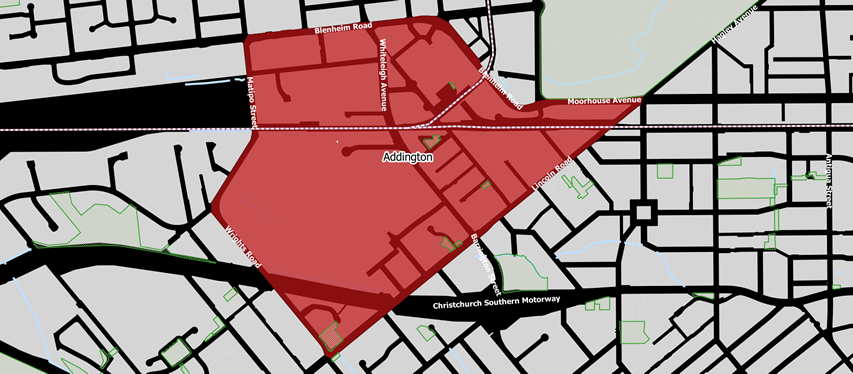
Download the Addington alcohol ban area map [PDF, 1.7 MB]
The area bounded by the following streets:
- Lincoln Road
- Moorhouse Avenue
- Blenheim Road
- Matipo Street
- Wrights Road
New Year’s Eve from 5pm on 31 December to 7am on 1 January each year.
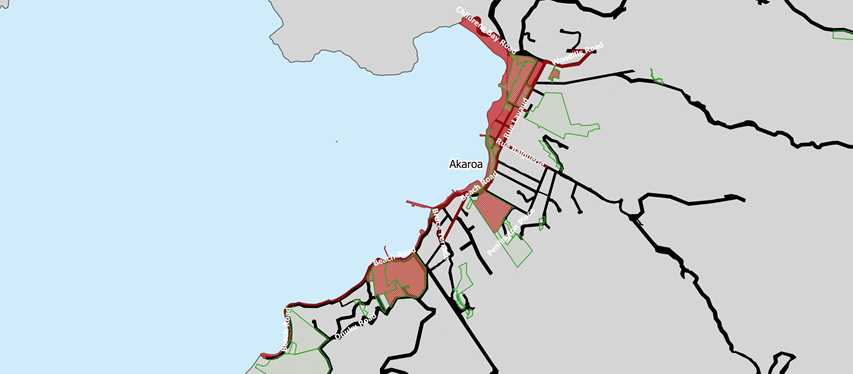
Download the Akaroa alcohol ban area map [PDF, 956 KB]
All of, or the relevant parts of, the following streets:
- Rue Lavaud
- Beach Road
- Rue Jolie
- Rue Balguerie up to Muter Street
- Rue Brittan
- Rue Croix
- part of Woodills Road up to and including the milk station turning area
- Bruce Terrace from Beach Road to Rue Jolie
- the lower part of Stanley Park (from Beach Road to Penlington Place)
This includes the following areas:
- Akaroa Beach and the waterfront area (including any wharf or jetty) from Children’s Bay to Takapunueke Reserve
- the Garden of Tane
- Waeckerle Green
- Reclamation Parking and Slipway Area
- Akaroa Recreation Ground
- Jubilee Park
- Childrens Bay
- War Memorial Grounds
At all times, 24 hours a day, seven days a week.
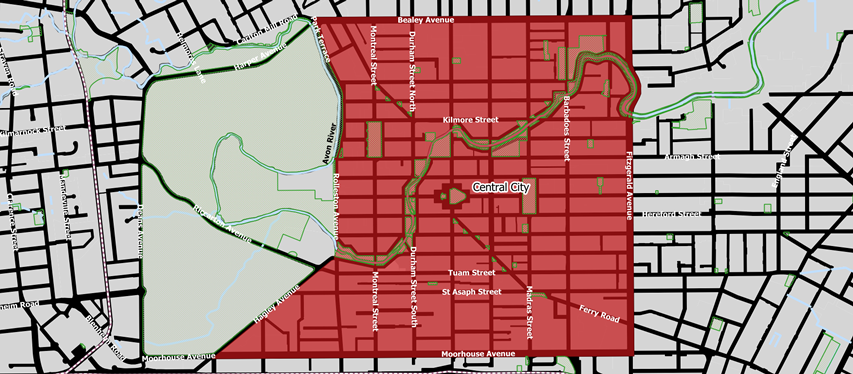
Download the Central city area map [PDF, 3.7 MB]
The area bounded by and inclusive of:
- Bealey Avenue
- Fitzgerald Avenue
- Moorhouse Avenue
- Hagley Avenue
- Rolleston Avenue
- the section of the Avon River that runs alongside Park Terrace from the Armagh Street Bridge to the Harper Avenue / Bealey Avenue Bridge
Seven days a week from 10pm to 7am.
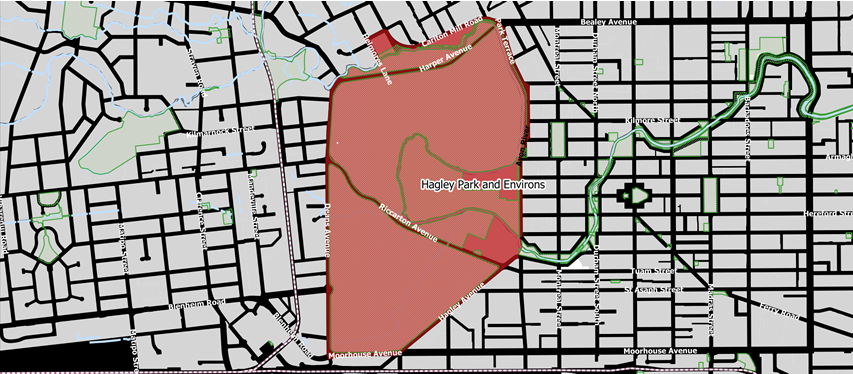
Download the Hagley Park alcohol ban area map [PDF, 2.7 MB]
The greater Hagley Park area, including:
- Hagley Park South
- Hagley Park North
- the Botanic Gardens
- Little Hagley Park and the area around Millbrook Reserve
- the streets included within and bounding this area, subject to the exceptions and further descriptions below
Note: this area runs adjacent to the 24-hour Central City alcohol ban area, but only applies from 10pm to 7am.
The streets or relevant parts of the streets that bound this area are as follows:
- Deans Avenue – the ban includes the whole of Deans Avenue
- Moorhouse Avenue – the ban includes the section of Moorhouse Avenue that runs alongside South Hagley Park (from Deans Avenue to Hagley Avenue)
- Hagley Avenue – the ban stops at the edge of the Park alongside Hagley Avenue, but does not include Hagley Avenue (Hagley Avenue is covered by the 24-hour Central City Alcohol Ban Area)
- Rolleston Avenue – the ban stops at the edge of the Park alongside Rolleston Avenue, but does not include Rolleston Avenue (Rolleston Avenue is covered by the 24-hour Central City Alcohol Ban Area)
- Carlton Mill Road – the ban includes the whole of Carlton Mill Road
- Rossall Street – the ban includes the section of Rossall Street that runs from Carlton Mill Road to Rhodes Street
- Rhodes Street – the ban includes the section of Rhodes Street that runs from Rossall Street to Helmores Lane
- Helmores Lane – the ban includes the section of Helmores Lane that runs from Rhodes Street to the Helmores Lane Bridge (and includes Helmores Lane from the Bridge to Harper Avenue inside the ban area)
The sections of the Avon River that form a boundary to the ban area are:
- Alongside Park Terrace (from the Armagh Street Bridge to the Harper Avenue/Bealey Avenue Bridge)
- Along the north side of Little Hagley Park (from the Helmores Lane bridge to the Fendalton Road/Deans Avenue Bridge)
At all times, 24 hours a day, 7 days a week.
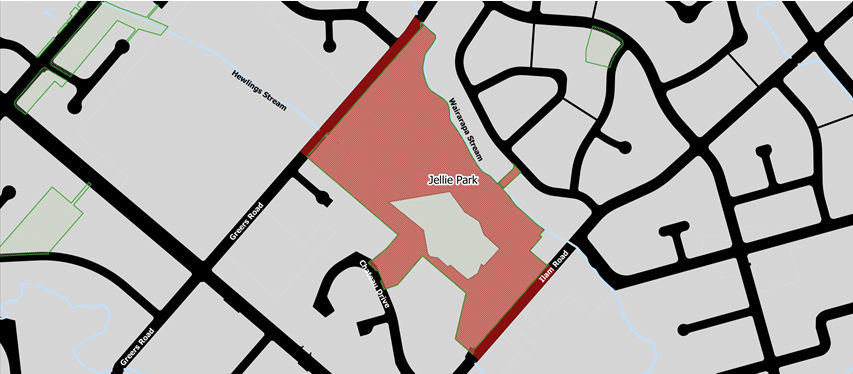
Download the Jellie Park alcohol ban area map [PDF, 805 KB]
The whole of Jellie Park, excluding the Jellie Park Pool Complex.
The ban extends to include Greers Road and Ilam Road.
At all times, 24 hours a day, 7 days a week.
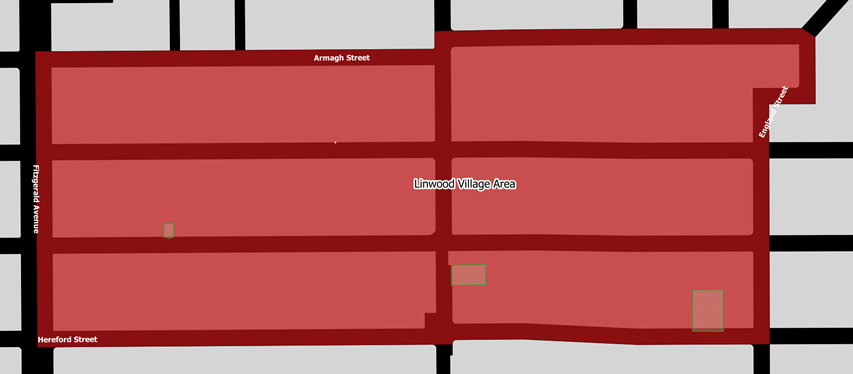
Download the Linwood Village Area map [PDF, 315 KB]
The area bounded by the following:
- Fitzgerald Avenue (East side)
- Both sides of the streets – Armagh Street, England Street, and Hereford Street
Seven nights a week from 6pm to 6am.
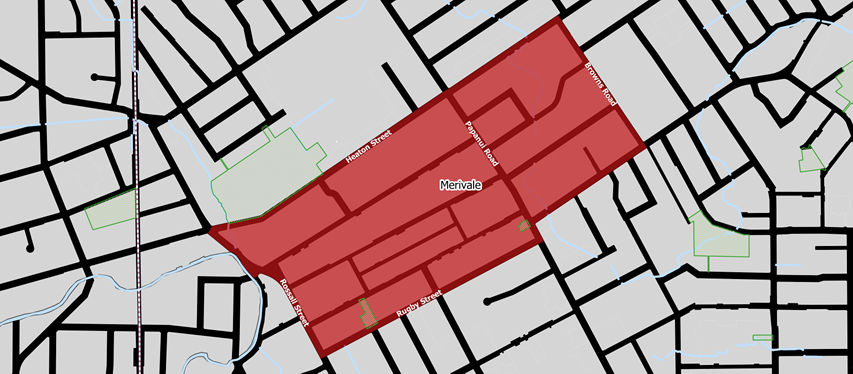
Download the Merivale alcohol ban area map [PDF, 1 MB]
The area bounded by and inclusive of all of, or the relevant parts of:
- Rossall Street
- Rugby Street
- Papanui Road
- St Albans Street
- Browns Road
- Innes Road/Heaton Street
At all times, 24 hours a day, 7 days a week.
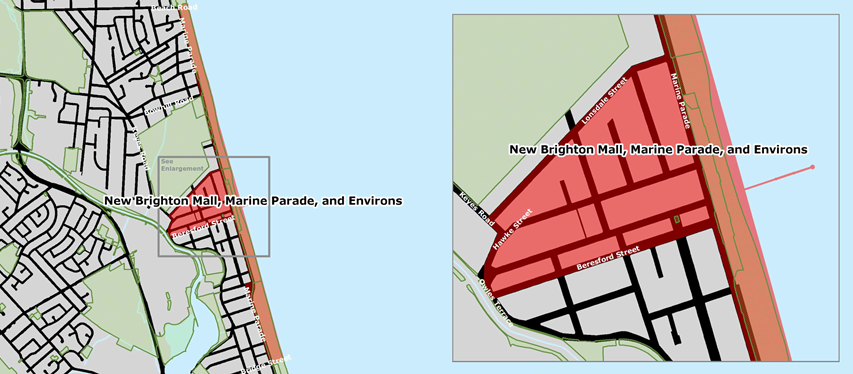
Download the New Brighton alcohol ban area map [PDF, 450 KB]
The area generally including New Brighton Mall, Marine Parade and the New Brighton beach area.
- New Brighton Mall – the area bounded by and inclusive of all of, or the relevant parts of, Marine Parade, Beresford Street, Owles Terrace, Hawke Street, Keyes Road and Lonsdale Street.
- Marine Parade and the New Brighton beach area - Marine Parade (from Beach Road to Bridge Street), and the beach alongside that section of Marine Parade, including the Pier, (down to the mean low water spring level)
New Year’s Eve from 5pm on 31 December to 7am on 1 January each year.
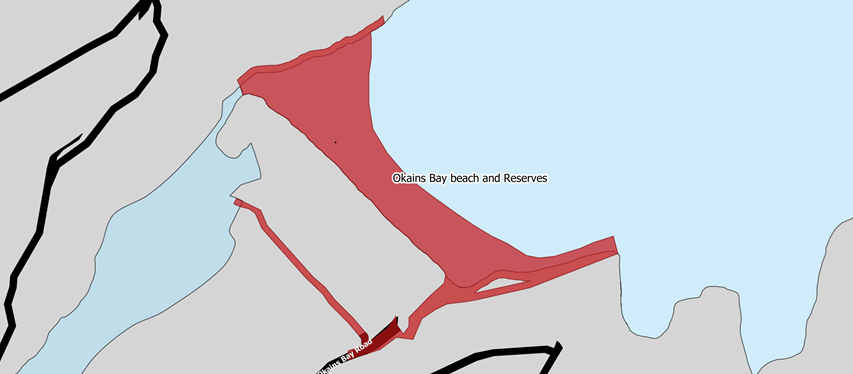
Download the Okains Bay alcohol ban area map [PDF, 173 KB]
The area being the Okains Bay beach and Okains Bay Road. This excludes the Okains Bay Camping Ground and a small parcel of adjacent land owned by the Department of Conservation.
Seven nights a week from 6pm to 6am.
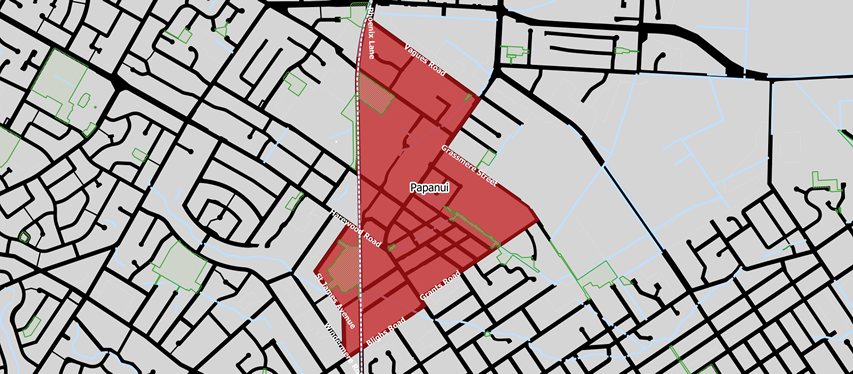
Download the Papanui alcohol ban area map [PDF, 1.6 MB]
The area bounded by and inclusive of all, or the relevant parts of:
- the cycle-walkway and the railway line from Vagues Road to Harewood Road
- St James Avenue
- Windermere Road
- Blighs Road
- Papanui Road
- Grants Road
- Grassmere Street
- Main North Road
- Vagues Road
- St James Park
At all times, 24 hours a day, 7 days a week.
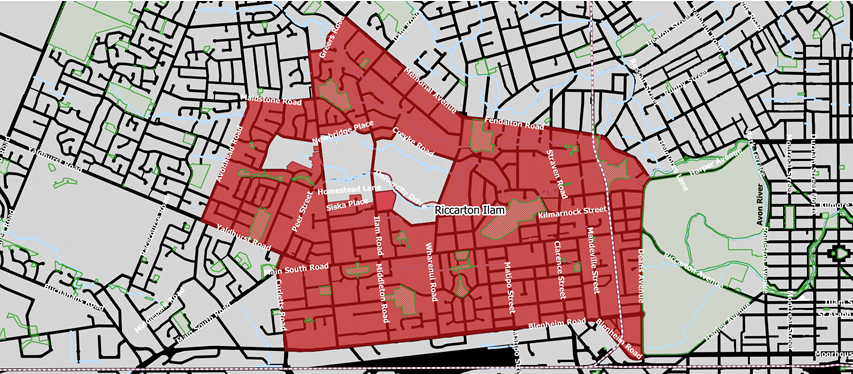
Download the Riccarton-Ilam alcohol restrictions map [PDF, 7.5 MB]
The area bounded by the following streets:
- Blenheim Road
- Curletts Road
- Yaldhurst Road
- Avonhead Road
- Maidstone Road
- Waimairi Road
- Greers Road
- Memorial Avenue
- Fendalton Road
- Deans Ave
- Blenheim Road
The ban area includes Ilam Primary School and University Drive, but, excludes any land forming part of the University of Canterbury campus and shown as excluded areas A, B, and C.
Applies from 7am to 12 midnight, Saturday of Cup Week (New Zealand Cup Day).
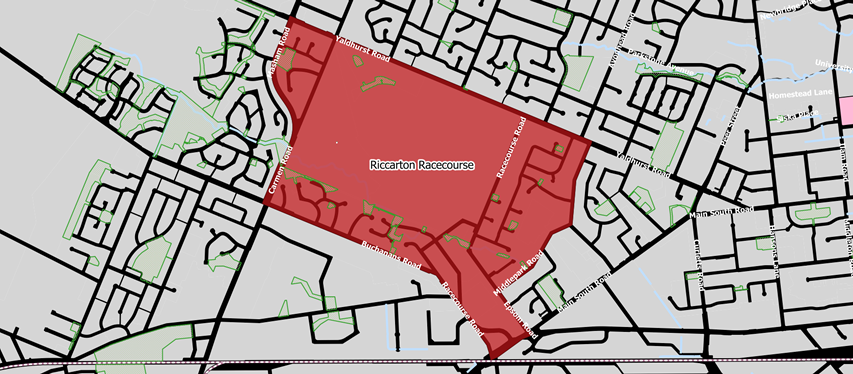
Download the Riccarton Racecourse alcohol ban area map [PDF, 2.8 MB]
The ban covers the area bounded by both sides of the following streets:
- Yaldhurst Road
- Middlepark Road
- Epsom Road
- Main South Road
- Racecourse Road
- Buchanans Road
- Carmen Road
- Masham Road
Applies while the fields are in use for rugby league between 3pm to 8.30pm on Monday to Friday, and between 9am to 6pm on Saturday and Sunday each week, from 1 April to 31 August each year.
Below are current sports fields allocated to rugby league to which the alcohol ban applies.
In addition, during all games and training sessions, alcohol ban signage will be displayed at the sports fields.
- Addington Park
- Bishopdale Park - rugby league field 1
- Bradford Park
- Branston Park
- Bromley Park - rugby league field 1
- Canterbury Agricultural Park
- Crosbie Park
- Cuthberts Green - rugby league fields 1 and 2
- Halswell Domain - rugby league fields 1, 2,3, and 4
- Hornby Domain - rugby league field 1
- Leslie Park
- Linwood Park
- MacFarlane Park - rugby league fields 1 and 2
- Nga Puna Wai - rugby league fields 1,2,3,4 and 5
- Papanui Domain - rugby league fields 1 and2
- Spreydon Domain - rugby league field 1
- Wainoni Park - rugby league fields 1 and 2
- Woolston Park - rugby league field 1
At all times, 24 hours a day, 7 days a week.
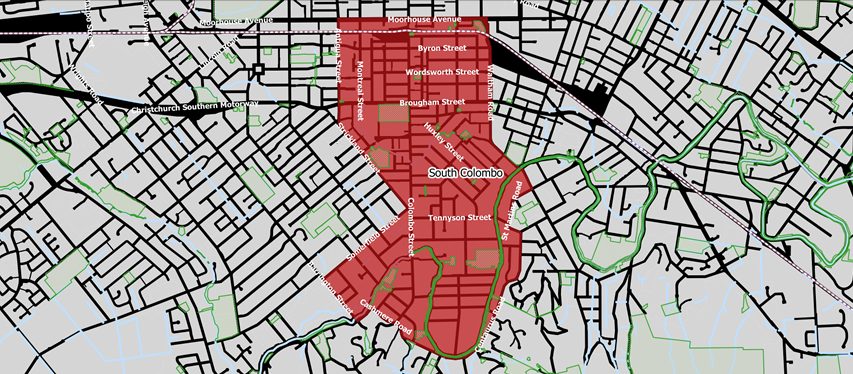
Download the South Colombo alcohol ban area [PDF, 4.9 MB]
The area bounded by and inclusive of all of, or the relevant parts of:
- Moorhouse Avenue
- Waltham Road
- St Martins Road
- Centaurus Road
- Cashmere Road
- Barrington Street
- Somerfield Street
- Strickland Street
- Antigua Street
New Year’s Eve from 8:30pm on 31 December to 6am on 1 January each year.
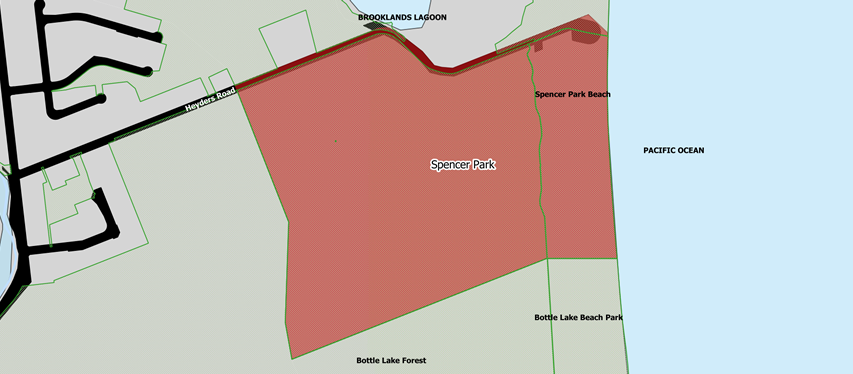
Download the Spencer Park alcohol ban area map [PDF, 2.3 MB]
That part of Spencer Park situated on the southern side of Heyders Road, commencing from 71 Heyders Road, Spencerville, and continuing to the beach, including the beach access and car parking areas.
Every week from 7pm Thursday night to midnight Sunday night. New Year's Eve from 7pm on 31 December to 7am on 1 January.
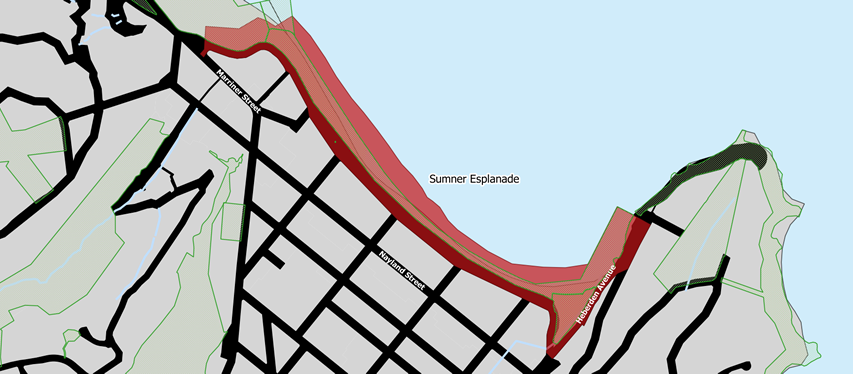
Download the Sumner Esplanade alcohol restrictions map [PDF, 1.1 MB]
The area bounded by and inclusive of:
- the whole of the Esplanade from Marriner Street to Heberden Avenue
- along Heberden Avenue from the Esplanade to the Sumner Boat Ramp car park
- Sumner Boat Ramp car park
- the beach that runs alongside this area down to the mean low water spring level
Applies at all times, 24 hours, seven days a week.
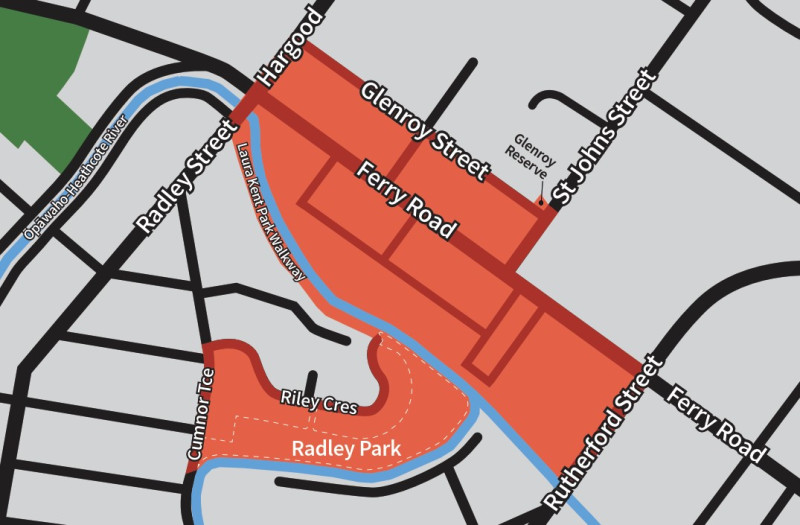
Download the Woolston Village alcohol ban area map [PDF, 50 KB]
The ban covers the area bounded by both sides of the following streets as shown in red above:
- Hargood Street
- Glenroy Street
- Glenroy Reserve
- St Johns Street
- Ferry Road
- Rutherford Street
- Heathcote River (running along Radley Park)
- Cumnor Terrace
- Riley Crescent
- Laura Kent Park walkway (along Heathcote River)
- Radley Street
Schedule 2 – Large-scale event alcohol ban areas
The bylaw allows the Council to impose temporary bans for large-scale events in Hagley Park, Rawhiti Domain/Thomson Park and Queen Elizabeth II Park.
Applies for a 24-hour period on the day of the large-scale event, commencing at 12am and concluding at 11.59pm.

Download the Hagley Park alcohol ban area map [PDF, 2.7 MB]
The greater Hagley Park area, including:
- Hagley Park South
- Hagley Park North
- the Botanic Gardens
- Little Hagley Park and the area around Millbrook Reserve
- the streets included within and bounding this area, subject to the exceptions and further descriptions below
Note: this area runs adjacent to the 24-hour Central City alcohol ban area, but only applies from 10pm to 7am.
The streets or relevant parts of the streets that bound this area are as follows:
- Deans Avenue – the ban includes the whole of Deans Avenue
- Moorhouse Avenue – the ban includes the section of Moorhouse Avenue that runs alongside South Hagley Park (from Deans Avenue to Hagley Avenue)
- Hagley Avenue – the ban stops at the edge of the Park alongside Hagley Avenue, but does not include Hagley Avenue (Hagley Avenue is covered by the 24-hour Central City Alcohol Ban Area)
- Rolleston Avenue – the ban stops at the edge of the Park alongside Rolleston Avenue, but does not include Rolleston Avenue (Rolleston Avenue is covered by the 24-hour Central City Alcohol Ban Area)
- Carlton Mill Road – the ban includes the whole of Carlton Mill Road
- Rossall Street – the ban includes the section of Rossall Street that runs from Carlton Mill Road to Rhodes Street
- Rhodes Street – the ban includes the section of Rhodes Street that runs from Rossall Street to Helmores Lane
- Helmores Lane – the ban includes the section of Helmores Lane that runs from Rhodes Street to the Helmores Lane Bridge (and includes Helmores Lane from the Bridge to Harper Avenue inside the ban area).
The sections of the Avon River that form a boundary to the ban area are:
- Alongside Park Terrace (from the Armagh Street Bridge to the Harper Avenue/Bealey Avenue Bridge)
- Along the north side of Little Hagley Park (from the Helmores Lane bridge to the Fendalton Road/Deans Avenue Bridge).
Applies for a 24-hour period on the day of the large-scale event, commencing at 12am and concluding at 11:59pm.
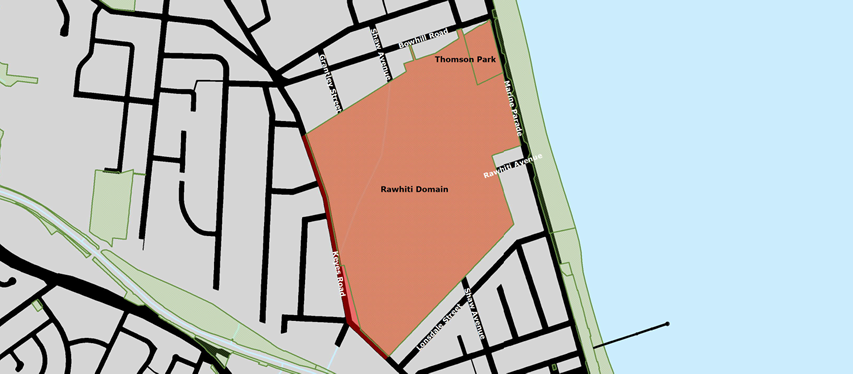
Download the Rawhiti Domain and Thomson Park alcohol ban area map [PDF, 299 KB]
The ban covers the areas of Rawhiti Domain and Thomson Park, including Keyes Road.
Applies for a 24-hour period on the day of the large-scale event, commencing at 12am and concluding at 11:59pm.

Download the Queen Elizabeth II Park alcohol ban area map [PNG, 132 KB].
The ban covers the area bounded by both sides of the roads of the following: Ascot Avenue, Bower Avenue, Travis Road, Frosts Road, Beach Road, and back to Ascot Avenue.
Requesting a new alcohol ban area
Requests for new alcohol ban areas should be made to the Governance Manager or Advisor of the Community Board for the affected area.
Please also refer to our guide on setting up an alcohol ban [PDF, 87 KB].
